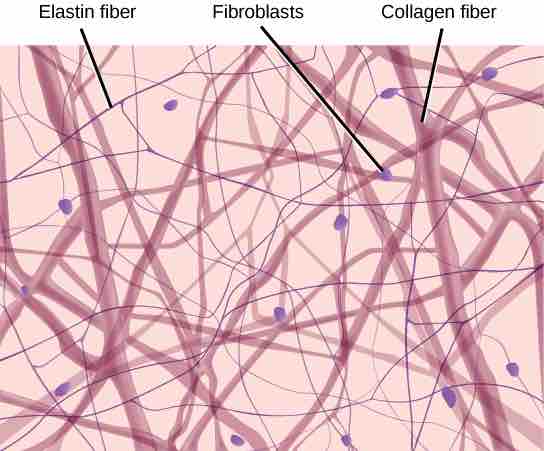Connective Tissues
Connective tissues are composed of a matrix consisting of living cells and a non-living substance, called the ground substance. The ground substance is composed of an organic substance (usually a protein) and an inorganic substance (usually a mineral or water). The principal cell of connective tissues is the fibroblast, an immature connective tissue cell that has not yet differentiated. This cell makes the fibers found in nearly all of the connective tissues. Fibroblasts are motile, able to carry out mitosis, and can synthesize whichever connective tissue is needed. Macrophages, lymphocytes, and, occasionally, leukocytes can be found in some of the tissues, while others may have specialized cells. The matrix in connective tissues gives the tissue its density. When a connective tissue has a high concentration of cells or fibers, it has a proportionally-less-dense matrix.
The organic portion, or protein fibers, found in connective tissues are either collagen, elastic, or reticular fibers. Collagen fibers provide strength to the tissue, preventing it from being torn or separated from the surrounding tissues. Elastic fibers are made of the protein elastin; this fiber can stretch to one and one half of its length, returning to its original size and shape. Elastic fibers provide flexibility to the tissues. Reticular fibers, the third type of protein fiber found in connective tissues, consist of thin strands of collagen that form a network of fibers to support the tissue and other organs to which it is connected.
Loose (Areolar) Connective Tissue
Loose connective tissue, also called areolar connective tissue, has a sampling of all of the components of a connective tissue. Loose connective tissue has some fibroblasts, although macrophages are present as well. Collagen fibers are relatively wide and stain a light pink, while elastic fibers are thin and stain dark blue to black . The space between the formed elements of the tissue is filled with the matrix. The material in the connective tissue gives it a loose consistency similar to a cotton ball that has been pulled apart. Loose connective tissue is found around every blood vessel, helping to keep the vessel in place. The tissue is also found around and between most body organs. In summary, areolar tissue is tough, yet flexible, and comprises membranes.

Loose connective tissue
Loose connective tissue is composed of loosely-woven collagen and elastic fibers. The fibers and other components of the connective tissue matrix are secreted by fibroblasts.
Fibrous Connective Tissue
Fibrous connective tissues contain large amounts of collagen fibers and few cells or matrix material. The fibers can be arranged irregularly or regularly with the strands lined up in parallel . Irregularly-arranged fibrous connective tissues are found in areas of the body where stress occurs from all directions, such as the dermis of the skin. Regular fibrous connective tissue is found in tendons (which connect muscles to bones) and ligaments (which connect bones to bones).

Fibrous connective tissue
Fibrous connective tissue from the tendon has strands of collagen fibers lined up in parallel. This arrangement helps the tissue resist tension that occurs from all directions.
Cartilage
Cartilage is a connective tissue. The cells, called chondrocytes (mature cartilage cells), make the matrix and fibers of the tissue. Chondrocytes are found in spaces within the tissue called "lacunae. "
A cartilage with few collagen and elastic fibers is hyaline cartilage. The lacunae are randomly scattered throughout the tissue and the matrix takes on a milky or scrubbed appearance with routine stains . Sharks have cartilaginous skeletons, as does nearly the entire human skeleton during some pre-birth developmental stages. A remnant of this cartilage persists in the outer portion of the human nose. Hyaline cartilage is also found at the ends of long bones, reducing friction and cushioning the articulations of these bones.
Hyaline cartilage
Hyaline cartilage consists of a matrix with cells called chondrocytes (shown here) embedded in it. The chondrocytes exist in cavities in the matrix called lacunae.
Elastic cartilage has a large amount of elastic fibers, giving it tremendous flexibility. The ears of most vertebrate animals contain this cartilage, as do portions of the larynx, or voice box. In contrast, fibrocartilage contains a large amount of collagen fibers, giving the tissue tremendous strength. Fibrocartilage comprises the intervertebral discs in vertebrate animals, which must withstand a tremendous amount of stress. Cartilage can also transform from one type to another. For example, hyaline cartilage found in movable joints, such as the knee and shoulder, often becomes damaged as a result of age or trauma. Damaged hyaline cartilage is replaced by fibrocartilage, resulting in "stiff" joints.